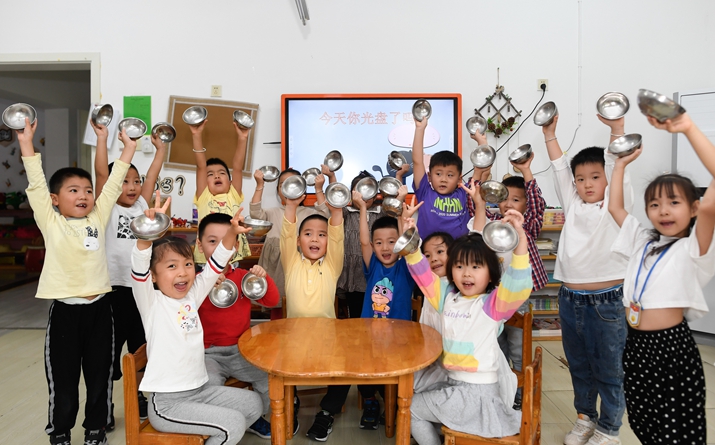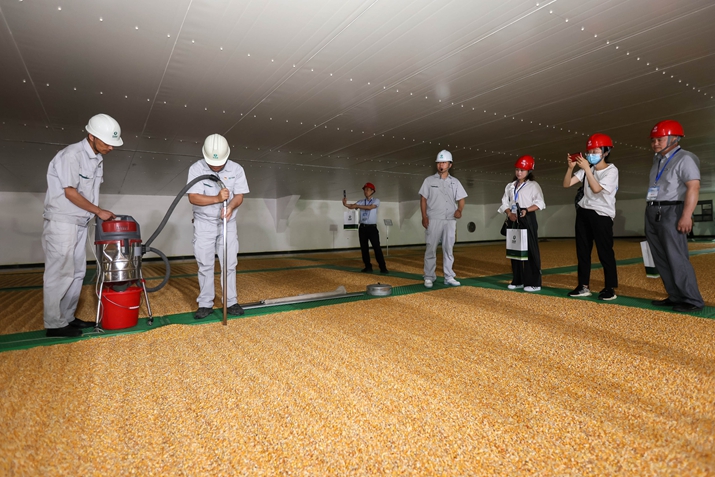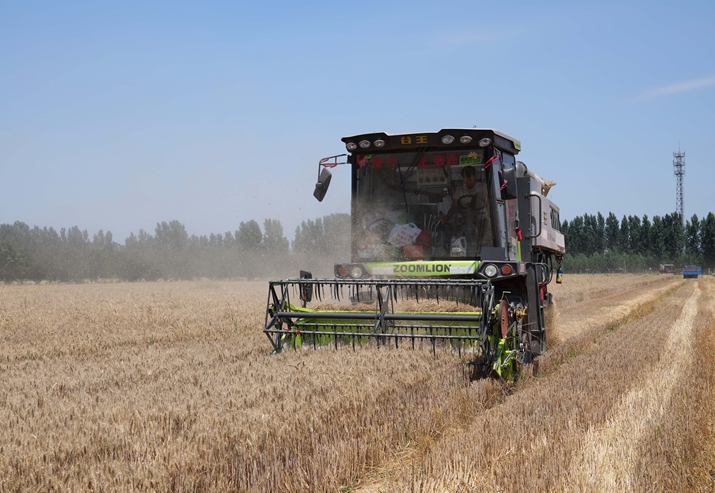| World |
| International conference calls for global efforts to reduce food loss | |
|
|
 Children at a kindergarten in Huzhou, Zhejiang Province, proudly show off their clean plates after lunch on September 22, 2020 (XINHUA)
Cui Chengxin, head of a rural cooperative in east China, estimated his cooperative had managed to reduce its grain loss rate from 4 to 1.5 percent by using machineries to harvest the crops. He lives in Jinan, capital of Shandong Province and the host city of the first International Conference on Food Loss and Waste, held both online and offline, from September 9 to 11. The conference, proposed by China at the first session of the 15th G20 Leaders' Summit in November 2020, centered on "reducing food loss and waste and promoting global food security." It aimed to build a global consensus, safeguard the world's food security and contribute to the zero hunger target the UN has included in its 2030 Sustainable Development Goals. In his congratulatory letter to the conference, President Xi Jinping called on countries around the world to take swift and concrete action to reduce food loss and waste. Noting the challenges posed by the COVID-19 pandemic, Xi named food security as a fundamental issue vis-à-vis the existence of humanity, and said that the reduction of food loss is an important way to ensure food security. Representatives from over 50 countries and regions attended the conference, including agricultural ministers from a number of G20 members such as Italy, the U.S., the United Kingdom, France and Indonesia, as well as diplomats, scholars, corporate executives and others.  Staff members check the corn conditions inside a Sinograin granary in Shanghai on June 24 (XINHUA)
A global problem According to the Food and Agriculture Organization (FAO) of the United Nations, food loss occurs along the food supply chain from harvest/slaughter/catch up to, but not including, the retail level. Food waste occurs at the retail and consumption levels. At present, food loss and waste are omnipresent. The FAO estimated in one of its annual flagship publications, The State of Food and Agriculture 2019, that 14 percent of the world's food is lost from post-harvest up to, but not including, the retail level. According to The Food Waste Index Report 2021, published by the United Nations Environment Program (UNEP) and partner organization WRAP, a non-profit organization based in the United Kingdom, an estimated 931 million tons of food, or 17 percent of total food available to consumers in 2019, disappeared into the waste bins of households, retailers, restaurants and other food services. In the meantime, as the pandemic still rants and raves, heavily disrupting the food supply chain, and extreme weather conditions such as extraordinarily high temperatures, severe droughts and ravaging storms have become frequent, international food prices remain high. All in all, global food security is deteriorating. In its latest annual Global Report on Food Crises, the FAO notes that 155 million people in 2020 experienced high levels of food insecurity, an increase of about 20 million people from the previous report and a new five-year high. Wu Laping, a professor with the College of Economics and Management at China Agricultural University, told Beijing Review that both food loss and waste are related to a country's economic development level. "Developing countries suffer serious food loss, whereas developed countries waste more," Wu said. Food loss in underdeveloped areas such as Africa and South Asia mainly occurs in the harvest and storage processes. For instance, 30 percent of food is lost in the storage process in the sub-Saharan region of Africa. However, food waste in developed countries such as the U.S. and West European nations mainly occurs in the consumption stage, with the U.S. wasting 21 percent of food, meaning the average American wastes around 124 kg of food every year. According to FAO estimates, in China, over 6 percent of food is lost or wasted in the harvesting, transportation, storage and processing processes every year. China's grain output in 2020 was 669.5 million tons and calculated according to the 6 percent rate, 40.15 million tons of grain were lost or wasted, tantamount to the overall output of major grain producer Anhui Province last year. Food loss and waste increases the consumption of resources such as land and water as well as the input of production materials such as fertilizer and pesticide, putting more pressure on the environment. Reducing food loss and waste can therefore help foster the sustainable development of agriculture. In sum, there are two ways to ensure food security: increasing output and reducing food loss and waste. However, restricted by resources and the environment by large, there is limited room for increasing output, which makes the reduction option the more urgent one. The annual global food output is roughly 2.8 billion tons. If waste was reduced by just one percentage point, 28 million tons of food could be saved, enough to sustain 70 million people for a year, China's Vice Minister of Agriculture and Rural Affairs Ma Youxiang said at a press conference on September 7. Wu added that as food loss and waste occur at different stages of the food supply chain in developing and developed countries, they should adopt different coping mechanisms. Underdeveloped economies should focus on the harvesting and storage phases and reduce the loss by promoting modern harvesting machineries, storage facilities and low-temperature transportation vehicles. Developed countries, on their part, should reduce waste in the consumption process.  A harvester works in a wheat field in a village in Tangshan, Hebei Province, on June 22 (XINHUA)
China's contribution In recent years, China has made great efforts to reduce food loss and waste by upgrading its agricultural facilities and logistics infrastructure, according to Ma. During the 13th Five-Year Plan (2016-20) period, China reduced its grain loss by an annual average of 13 million tons in the process of circulation. Since 2012, the Clean Plate campaign has been implemented across the country. Food waste, especially that of meals paid through public funding, has been effectively curbed. However, it still exists. In August 2020, President Xi made an instruction stating that food waste is shameful and effective measures must be adopted to curb it. In April, China's top legislature enacted the Anti-Food Waste Law, stating that the country encourages a healthy, resource-conserving and environmentally friendly way of consumption and a simple, moderate, green and low-carbon way of life. Catering service providers, if misleading consumers to order more than they need and thus causing waste, should be ordered to correct their practices. Those refusing to comply may receive a fine ranging from 1,000 to 10,000 yuan ($155 to 1,550). As the first province to have its gross agricultural output value surpass 1 trillion yuan ($155.2 billion), Shandong has taken a series of efforts to reduce food loss in the production, harvesting, and storage processes, and formed an applicable model for minimizing food loss. The Jinan grain storage warehouse under China Grain Reserves Group Ltd. (Sinograin), the country's largest grain storage and transportation company, features a number of vast barns. High-resolution cameras in the barn ensure staff can check the conditions of the wheat kernel without entering the barn. "The barn is equipped with central air-conditioning as well as ventilation and temperature control systems. A temperature below 15 degrees Celsius is maintained at all times to prevent the grain from going bad," An Xiyou, deputy head of the storage management department at the Jinan grain storage warehouse, told Xinhua News Agency. At present, Sinograin has installed over 4,500 cameras and 280,000 temperature sensors across its Shandong-based granaries to monitor grain conditions, reducing the loss rate to below 1 percent. Zhongyu Food Co. Ltd. in Binzhou, Shandong, has adopted a new technology to extract the dietary fiber from wheat bran to make flour and noodles. The method has turned trash, as the bran was previously used as fodder, into treasure and barred food loss in the processing stage. Fada Flour Group in Dezhou, Shandong, too, has upgraded its production equipment and technologies to increase flour yield. "We previously had an annual output of 2.3 million tons of flour. By upgrading our equipment and technologies, we can now produce 184,000 more tons of flour every year," Sun Jinfeng, marketing director of the flour group, explained. "Improving flour yield by making full use of every wheat kernel is an effective way to prevent food loss." In addition to domestic efforts, China has cooperated with other countries in food loss reduction through information sharing, technology exchange and personnel training under the frameworks of the FAO, G20 and Asia-Pacific Economic Cooperation. "In the future, China will carry out joint research plus development of technologies and equipment with other developing countries to help them reduce food loss in the production stage," Sui Pengfei, director of the international department of the Ministry of Agriculture and Rural Affairs, said at the press conference. Wu concluded that as developed countries are more advanced in technology, they should shoulder more responsibility in terms of minimizing food loss. For instance, developed countries can help those weaker regions reduce food loss in the harvesting and storage stages by providing the latter with technological support. They can also lessen waste through legislation or awareness-raising campaigns and spread the relevant experiences to developing countries. Last, but not least, they could also donate their food surplus to those in need around the world. (Print Edition Title: Saving Food) Copyedited by Elsbeth van Paridon Comments to jijing@bjreview.com |
|
||||||||||||||||||||||||||||
|